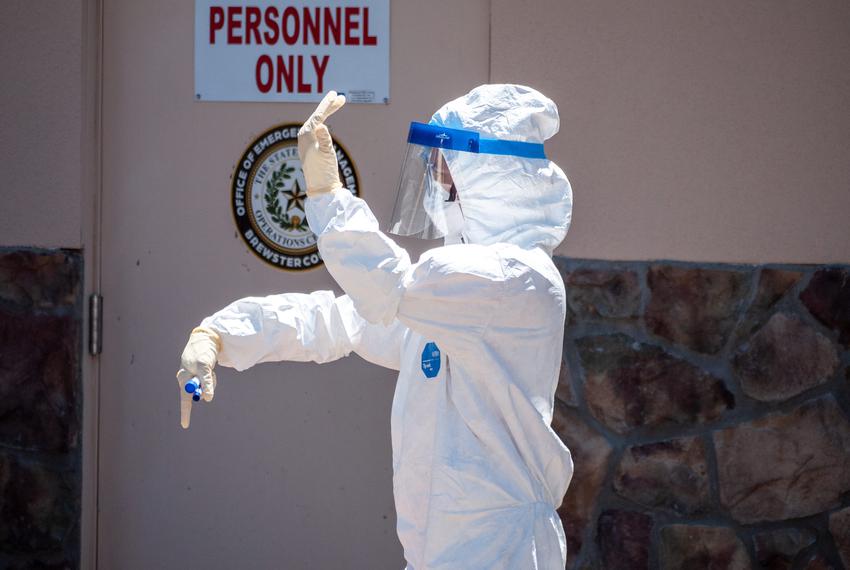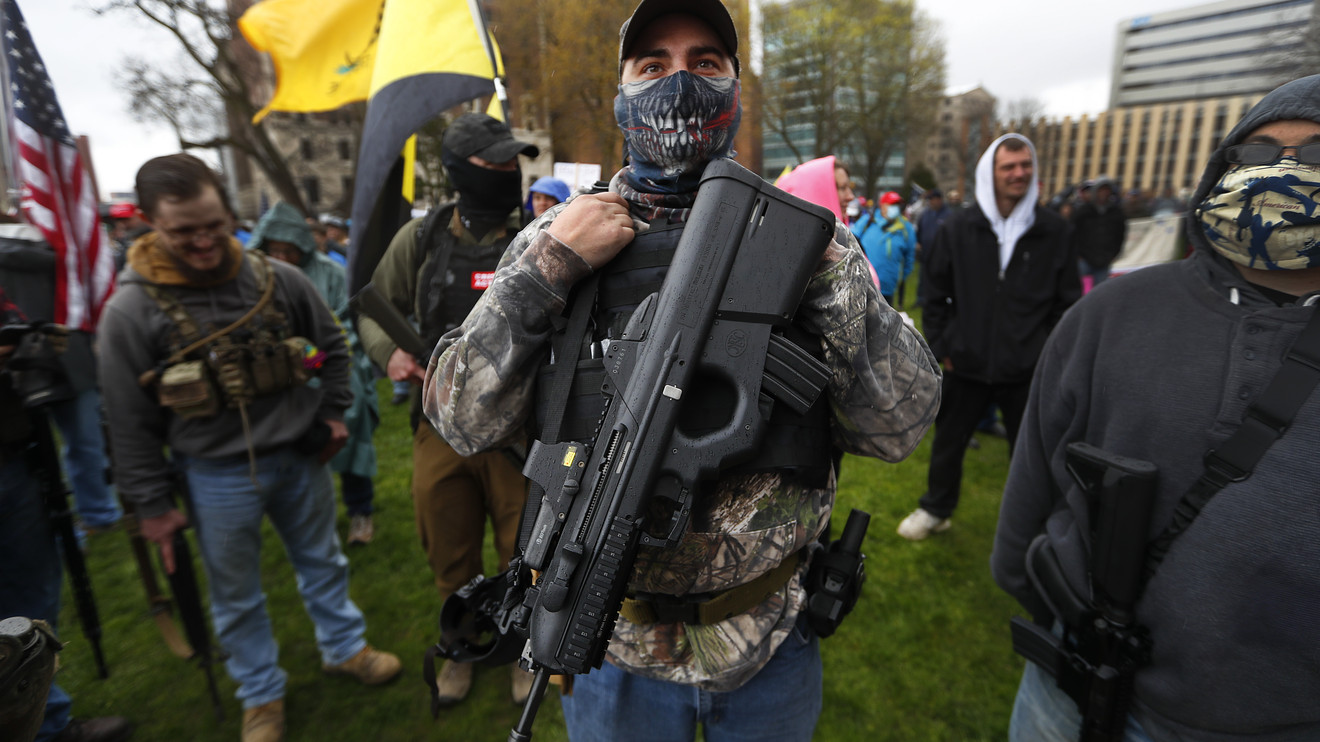
In the US, Covid 19 has killed nearly 141,000 people and infected 3.8 million — both by far the highest numbers in the world. The US has more than a quarter of the deaths and infections in the entire world, yet only a little more than 4% of the population. As cases continue to spike, tensions spike over schools reopening. As schools across the country prepare to reopen for in-classroom learning, teachers are trying to figure out the safest way to resume in-person education. While some schools have given the option for online courses, others are still working on plans to return to the classroom. Lawmakers in Washington are pushing to include a provision in a new coronavirus relief package tying school funding to the reopening of classrooms. Many public health officials fear the reopening of schools could lead to a new surge in COVID-19 deaths and hospitalizations.
Three teachers in Arizona were sharing a classroom for two hours a day teaching online summer school classes during the pandemic. Despite following protocols — social distancing, wearing masks and gloves, and using hand sanitizer — they were all sickened by the coronavirus. Kimberley Chavez Lopez Byrd, 61, died June 26, less than two weeks after she was hospitalized. The two surviving teachers, Jena Martinez and Angela Skillings, said that it is not yet safe for kids, or teachers, to return to the classroom. Martinez said that when they began to do their online schooling from campus, they followed plans in place meant to keep them safe from the virus.
In Arizona, teachers want Governor Doug Ducey to push the start of in-person school to at least early October after the beloved educator died of COVID-19 teaching summer school and statewide hospitalizations and deaths spiral. At stake, Arizona teachers say, is the safety of the state’s 1.1 million public school students and 20,000 teachers. Arizona has been hit hard by the virus this summer as its 7-day average of new cases has gone from 500 at the end of May to more than 3,000 in July, while hospitals’ intensive care capacity, according to most recent data from Arizona Department of Public Health, stood at a nearly 90% percent last week.
Florida has reported more than 10,000 new coronavirus cases for the sixth day in a row. On Monday, Florida’s largest teachers’ union sued Republican Governor Ron DeSantis to block his order requiring all schools to reopen next month despite the growing pandemic, which has killed nearly 5,200 Floridians.
Meanwhile, Missouri Governor Mike Parson is insisting students go to school despite the risk of the virus. He received backlash after giving an interview where he said “These kids have got to get back to school. They’re at the lowest risk possible. And if they do get COVID-19, which they will — and they will when they go to school — they’re not going to the hospitals. They’re not going to have to sit in doctor’s offices. They’re going to go home and they’re going to get over it. We gotta move on,” he continued. “We can’t just let this thing stop us in our tracks.” Many criticized his statement calling it “stunning ignorance” saying the virus “doesn’t stop with our children. The teachers, bus drivers, janitors, food service workers, parents, grandparents and neighbors who our children see every day are susceptible to this virus, too. We need a plan that keeps all Missouri families safe.” Missouri has 47,519 confirmed cases and 1,268 deaths.
It is still unclear how frequently children transmit the virus to others. Some data suggests children are less susceptible to contracting the virus and spreading it to adults. According to the CDC, 175,374 cases have been confirmed in kids ages 17 and under, accounting for approximately 6% of all confirmed cases. A large study recently shared out of South Korea found children between the ages of 10 and 19 can spread the virus as much as adults do, while children younger than the age of 10 transmit the virus to others less often than adults.
Read more

Two Indiana men were charged in an alleged assault against a Black man who was seen in a viral video being held against his will in the woods near an Indiana lake on the Fourth of July. Sean Purdy and Jerry Cox are charged with various crimes, including confinement and battery against 36-year-old Vauhxx Booker. Purdy and Cox were part of a group of five men who pinned Booker to a tree, beat him and threatened to lynch him. Booker was able to escape them after passersby intervened. A portion of the assault was captured on video by the strangers who intervened.
Monroe County Prosecutor Erika Oliphant has filed two active warrants for the two men and says Booker will face no charges. Purdy is charged with criminal confinement, battery resulting in injury and intimidation, all felonies. Cox is charged with aiding or causing criminal confinement, felony battery resulting in injury, intimidation and two misdemeanor counts of battery.
Booker, a member of the Monroe County Human Rights Commission, posted his account of the July 4 incident along with video to his Facebook account, writing, “I don’t want to recount this, but I was almost the victim of an attempted lynching.” He went on: “On July 4th evening others and me were victims of what I would describe as a hate crime. I was attacked by five white men with Confederate flags who literally threatened to lynch me in front of numerous witnesses.”
Booker said he and his friends were visiting a public beach on Lake Monroe outside Bloomington to join a gathering when a group of white men said they were on private property and began following them. Some of the men became belligerent, he said. When he approached “sober seeming group members” to “see if we could smooth things over a bit,” the confrontation escalated. Video posted to social media shows a group of white men holding Booker to a tree as his friends plead with them to release him. In the video, one man shouts at the camera, “You happy about this, you nappy-headed bitch? You and your five white friends?” As Booker’s friends leave, one of the men follows, shouting, “Those Black boys want to start it all.”
Booker says during the attack there were shouts of “get a noose” and “white power,” although those are not heard on the video. Booker believes he’s alive because strangers stopped to help and film the altercation. “The reason why I’m here today is simply because these folks, they didn’t just stop and watch and film my execution,” Booker said in an interview with NPR’s Mary Louise Kelly. “They became involved. They became active participants. They put themselves in danger when they stepped forward for me.”
Last week, the FBI confirmed it was investigating the incident as a potential hate crime, and Indiana Gov. Eric Holcomb called it “beyond disturbing.” “The brief video clip that I viewed with my own two eyes was beyond disturbing and that’s why it’s very important that the DNR … complete their investigation sooner rather than later.” Bloomington
Mayor Greg Hamilton, who said he has known Booker personally for at least five years, said his city had work to do. “I don’t know what would have happened in the woods around Lake Monroe if there hadn’t been other individuals there and if there hadn’t been a video taken,” Hamilton told Yahoo News. “It’s incredibly important that we as a country, and then me and my community, that we make clear that has no place in our community, and we want to root it out.”
Read more

More than a year after launching an internal investigation into 138 employees for “inappropriate social media activity,” Customs and Border Protection — the parent agency of the Border Patrol — has removed four employees, suspended 38 without pay and disciplined an additional 27 with reprimands or counseling. Investigators from Customs and Border Protection‘s Office of Professional Responsibility determined that 63 of the cases — roughly half — were “unsubstantiated.” Six cases remain open, and the Homeland Security Department‘s inspector general is also investigating.
The office began looking into more than 60 current employees and eight former staff following reports of a secret Facebook group in which members used dehumanizing and derogatory language regarding Latina members of Congress and deceased migrants. The existence of the group, known as “I’m 10-15,” the code used by Border Patrol for migrants in custody, at one point had 9,500 members and was created in August 2016. The probe, which is not criminal, ultimately doubled the number of individuals under investigation, and included several additional private social media groups.
Most of the cases deemed unsubstantiated involved personnel who reported themselves or others as part of the groups and provided information to investigators, but whose history showed they’d never posted or been active in them. At the start of the investigation, Matthew Klein, assistant commissioner of the agency’s Office of Professional Responsibility, emphasized that the privacy of the social media groups does not protect current or former employees from disciplinary action.
Members of the secret Facebook group for current and former Border Patrol agents joked about the deaths of migrants and discussed throwing burritos at Latino members of Congress visiting a detention facility while referring to them as scum buckets. In one post, a photoshopped image depicted Congressmember Alexandria Ocasio-Cortez being sexually assaulted by President Trump. In another thread, members of the group made fun of a video of an immigrant man trying to carry a child through a raging river in a plastic bag. One group member commented, “At least it’s already in a trash bag.”
In one exchange, group members responded with indifference and wisecracks to the post of a news story about a 16-year-old Guatemalan migrant who died in May while in custody at a Border Patrol station in Weslaco, Texas. One member posted a GIF of Elmo with the quote, “Oh well.” Another responded with an image and the words “If he dies, he dies.”
Rep. Veronica Escobar, who said on Twitter she was “one of the Latina members of Congress targeted by the hateful attacks,” but she had not received information about the investigation from Customs and Border Protection. Rep. Joaquín Castro, the head of the Congressional Hispanic Caucus, reviewed the Facebook discussions and was incensed. “It confirms some of the worst criticisms of Customs and Border Protection,” said Castro. “These are clearly agents who are desensitized to the point of being dangerous to migrants and their co-workers.” He added that the agents who made the vulgar comments “don’t deserve to wear any uniform representing the United States of America.”
Read more

The U.S. coronavirus outbreak continues with over 3 million confirmed cases as more states reported record numbers of new infections, and Florida faced an impending shortage of intensive care unit hospital beds. Additional hospitalizations could strain healthcare systems in many areas, leading to an uptick in deaths from the respiratory illness that has killed more than 131,000 Americans since the pandemic began and many survivors are grappling with long-term complications. Authorities have reported alarming increases of daily caseloads in roughly two dozen states over the past two weeks, a sign that efforts to control transmission of the novel coronavirus have failed in large swaths of the country.
Last week, the country averaged just under 50,000 new cases daily — the highest rate recorded, and twice as high as a month ago. An influential coronavirus model has increased its projections for US deaths and it’s now forecasting more than 208,000 deaths by November. Experts say that face masks could save as many as 45,000 US lives by November if 95% of the population wears a covering in public, according to the Institute for Health Metrics and Evaluation (IHME) at the University of Washington, which built the model.
California, Hawaii, Missouri, Montana, Oklahoma and Texas shattered their previous daily record highs for new cases. California reported more than 10,000 coronavirus cases in one day, a record rise for a single day that also surpassed the number of contact tracers recently trained by the state to detect and prevent potential outbreaks. About 24 states have also reported disturbingly high infection rates as a percentage of diagnostic tests conducted over the past week. New COVID-19 infections have risen in 42 states in the past two weeks. Only three other U.S. states have reported more than 10,000 cases in a day. Florida reported 11,458 new cases on July 4 and Texas reported 10,028 on July 7.
At least 56 intensive care units in Florida hospitals had reached capacity on July 7, state officials said. Another 35 hospitals show ICU bed availability of 10% or less, according to the Agency for Health Care Administration in that state. Georgia surpassed 100,000 reported coronavirus cases, becoming the ninth state to pass the mark. In California, the number of hospitalizations across the state were at an all-time high and the virus positivity rate jumped more than 2% in Los Angeles.
New York recorded 12,847 new infections on April 10, three weeks after the state implemented a strict lockdown that closed most businesses. Once the epicenter of the U.S. epidemic, New York saw cases rise by about 6% in June – the lowest rate in the entire country. In Texas, the number of hospitalized patients has more than doubled in just two weeks. The U.S. Department of Health and Human Services said it was adding short-term “surge” testing sites in three metropolitan areas in Florida, Louisiana and Texas.
Affecting nearly one of every 100 Americans, the surge has forced authorities to backpedal on moves to reopen businesses, such as restaurants and bars, after mandatory lockdowns in March and April reduced economic activity to a virtual standstill and put millions of Americans out of work.
Governors and mayors in many states have ordered people in hotspot counties to wear face coverings in public. Recently published research found that on average, the time from exposure to symptom onset (known as the incubation period) is about five to six days. However, studies have shown that symptoms could appear as soon as three days after exposure to as long as 13 days later. That is why contact tracing is so important in controlling the spread of the coronavirus although in parts of the south and southwest, cases are now rising so quickly that experts are warning contact tracing isn’t possible any more.
Read more

With mass uprising over police brutality showing no signs of abating, more policy changes are taking shape around the country. San Francisco announced last week that trained, unarmed professionals will respond to noncriminal calls instead of police. Colorado lawmakers passed a bill to introduce sweeping police changes, including banning choke holds and requiring officers to intervene if they see excessive force being used. Boston Mayor Marty Walsh said he will reallocate $3 million from the police department’s budget toward public health initiatives. The Minneapolis City Council unanimously passed a resolution to replace the police department with a community-led public safety system. Minneapolis Councilmember Alondra Cano said, “We acknowledge that the current system is not reformable, that we would like to end the current policing system as we know it.”
Connecticut Governor Ned Lamont imposed a series of reforms on the Connecticut State Police, including a ban on choke holds, a mandate that officers use body cameras and dashboard cameras, and restrictions on a program that funnels military equipment to local law enforcement. Iowa Governor Kim Reynolds signed a police reform bill into law, prohibiting the use of a choke hold in an arrest “except when a person cannot be captured any other way or has used or threatened deadly force” and preventing an officer from being hired in Iowa if they have a previous felony conviction, were fired for misconduct, or left before they could be fired for misconduct. The bill also requires annual anti-bias and deescalation training for law enforcement and allows the Iowa Attorney General to prosecute officers for a criminal offense resulting in the death of a human being.
Michigan State Senator Jeff Irwin introduced Senate Bill 945 which would require the addition of “implicit bias, deescalation techniques, and mental health screening” as part of the Michigan Commission on Law Enforcement Standards certification process for new law enforcement officers. The bill was drafted before the death of George Floyd in response to the broader problem of police brutality and passed the State Senate unanimously on June 4. Kansas City Mayor Quinton Lucas announced a series of police reforms, including whistle blower protections, independent review of officer-involved shootings, and use of body cameras by police officers. New Jersey has banned police departments from using choke holds and similar neck and carotid restraints. According to Attorney General Grewal’s order, “Because these tactics create a substantial risk of death or serious bodily harm, officers who cause a subject’s death or injury while performing them face potential criminal liability” except when “deadly force is necessary to address an imminent threat to life”.
Meanwhile, counties and cities across the country, including Cleveland, Denver and Indianapolis, are declaring racism a public health crisis. Seattle City Council member Kshama Sawant is calling for a section of downtown known as the Capitol Hill Autonomous Zone to remain permanently in community control. Protesters took over several city blocks last week after the Seattle Police Department abandoned its Capitol Hill precinct and stopped trying to violently disperse marches. The Seattle City Council voted unanimously to ban police use of tear gas and choke holds.
The New York Police Department announced it is dismantling its plainclothes anti-crime unit and the 600 officers in the unit will be reassigned. In 2018, news outlets reported plainclothes anti-crime officers had been involved in 31% of fatal police shootings in New York since 2000. Meanwhile, Albuquerque, New Mexico, has announced plans to create a new civilian department made up of social workers and others to respond to non-emergency 911 calls. In Georgia, the state Legislature reopened with a call to pass a hate crimes bill. Georgia is one of four states with no hate crime laws.
Read more

With more than 2.06 million cases, America has the world’s largest COVID-19 confirmed cases to date. It’s also first when it comes to the total number of deaths, with more than 117,000 people having died of COVID-19 complications. Nearly 7.5 million people have had confirmed infections worldwide and over 420,000 people died. As US states are opening up their economies, Harvard Global Health Institute director Dr. Ashish Jha predicts that the US will cross 200,000 deaths sometime in September. Jha explained his estimates only take into account the next few months, but COVID-19 will obviously not disappear after that.
“The pandemic won’t be over in September so I’m really worried about where we’re going to be in the weeks and months ahead. We’re really the only major country in the world that opened back up without really getting our cases as down low as we really needed to,” Jha noted, adding that the US is the only advanced country in the world not to have a proper contact tracing system setup. People should continue to maintain social distancing and wear masks, Jha advised. They should also “put pressure” on the government to advance testing and contact tracing programs.
“But even if we assume that it’s going to be flat all summer, that nothing is going to get worse, we’re going to stay flat all summer — even if we pick that low number, 800 a day — that’s 25,000 a month,” Jha pointed out. “In three and a half months, we’re going to add another 87- 88,000 people, and we will hit 200,000 sometime in September.” Jha said anyone who still thinks the summer will bring a dramatic decrease in cases is “engaging in wishful thinking.” Coronavirus cases and associated hospitalizations may be falling in Massachusetts, New York, New Jersey, and Connecticut, he said, but cases are surging in Arizona, Texas, Florida, and the Carolinas. The Harvard professor of public health said he is not trying to scare people into staying home by raising concerns about the number of deaths he’s predicting.
In Brazil, the coronavirus death toll has topped 43,000 with the total number of confirmed cases at over 850,000. It now has the second-highest number of COVID-19 deaths and cases in the world behind the United States. According to the health ministry, the COVID-19 mortality rate in Brazil is five% and nearly 388,500 people have recovered from COVID-19 in Brazil.
China reported its highest number of daily infections in months, raising concern over a second wave of the outbreak. In Beijing, authorities have reimposed lockdown measures after a new cluster of cases emerged last week. The cluster, the capital’s first locally transmitted cases in nearly two months, raised mainland China’s total number to 83,132. Almost 4,700 people have died in China, where the pandemic originated in December.
The World Health Organization says the pandemic is accelerating in Africa, with the most affected countries being South Africa, Algeria, Nigeria, Egypt and Sudan. In Yemen, medical authorities warn deaths linked to the pandemic could exceed war-related fatalities in the port city of Aden. The best way to prevent illness is to avoid being exposed to this virus. Learn how COVID-19 spreads and practice these actions to help prevent the spread of this illness.
Covid 19 isn’t going anywhere anytime soon so the recommendations to help prevent the spread of COVID-19 as the world’s economy reopens are: Keep 6 feet of social distance between yourself and others; wear a mask or cloth covering when around others-especially when in situations where you can’t maintain the 6 feet of social distancing; clean your hands often, either with soap and water for 20 seconds or a hand sanitizer that contains at least 60% alcohol; avoid close contact with people who are sick; disinfect frequently touched surfaces regularly and stay home if you are feeling any symptoms.
Read more

Authorities in Georgia have arrested a third man in the shooting death of Ahmaud Arbery, the 25-year-old man who was chased down and shot to death by two men in February. The man, William “Roddie” Bryan, 50, was arrested on charges of felony murder and attempted false imprisonment. He filmed the video showing Arbery jogging down a narrow road in Brunswick, Georgia, in broad daylight, before being ambushed. Retired police officer Gregory McMichael and his son Travis were both arrested and charged with murder and aggravated assault earlier this month.
The video Bryan recorded on his cellphone shows Arbery trying to run around the McMichaels’ truck before turning sharply toward Travis McMichael and tussling over his shotgun. Arbery was shot three times and collapsed in the street. The 36-second video was not released until more than 10 weeks after the killing and spurred calls for the McMichaels’ arrests. It does not show what led up to the final moments of Arbery’s life.
Gregory McMichael — a former prosecutorial investigator, ex-Glynn County police officer and Travis’ father — told police that he and his son chased Arbery after seeing him at a neighbor’s under-construction home. They said he fit the description of a suspect in a rash of break-ins, according to an incident report. Surveillance footage from inside the under construction home show Arbery entered the home and was inside for approximately 3 minutes looking around but he did not take anything before leaving to continue his jog.
Bryan is accused of using his vehicle on multiple occasions between about 1 p.m. and 1:20 p.m. that day to “attempt to confine and detain Ahmaud Arbery without legal authority,” the warrant states. Investigators believe this “underlying felony helped cause the death of Ahmaud Arbery,” Georgia Bureau of Investigation Director Vic Reynolds said, referring to the charge of attempted false imprisonment. Bryan’s lawyer Kevin Gough, had said his client committed no crime, was no vigilante and would be the state’s “star witness.” He said his client has no relationship with the McMichaels. Bryan’s name appears in the police report filed the day of the shooting. Gregory McMichael told police that after he and his son Travis attempted and failed to stop Arbery, “Roddy” tried to intercept him, according to the report.
Gough told new outlets last week that Bryan was working in his yard when he saw a person he did not know being chased by a vehicle he recognized from the neighborhood. During an interview, Bryan said he prays for the Arbery family every night and said of the video, “I hope that it, in the end, brings justice to the family and peace to the family.”
The attorneys representing members of the Arbery family said they were relieved. “We called for his arrest from the very beginning of this process,” the family’s attorneys S. Lee Merritt, Benjamin Crump, and L. Chris Stewart, said. “His involvement in the murder of Mr. Arbery was obvious to us, to many around the country and after their thorough investigation, it was clear to the GBI as well. I can say Wanda Cooper and Marcus Arbery were very, very relieved to see this arrest finally take place. Not only have we been waiting since the McMichaels were arrested, they have been waiting for three months for all three of these men to be brought into custody,” Merritt said.
Bryan was booked into the Glynn County Jail, where the McMichaels are being held on charges of murder and aggravated assault. The father and son’s legal teams have said the full details of the case haven’t made it into the public arena, and they’ve promised the truth will exonerate their clients.
Read more

The United Food and Commercial Workers Union, the country’s largest meatpacking workers’ union, is condemning the reopening of 14 meatpacking plants under a recent executive order by the US Administration. The union is calling for CDC coronavirus safety guidelines to be made mandatory, as at least 30 meatpacking workers have died of COVID-19 and over 10,000 have been exposed to or infected by the coronavirus. The industry work practices under normal circumstances tend to put workers in close proximity to each other, working at high speed as they cut up animal carcasses.
The pandemic caused at least 30 meatpacking plants to temporarily close over the past two months, resulting in a 40% drop in pork production capacity and a 25% drop in beef production capacity, the union said. The U.S. Agriculture Department said 14 plants that had closed due to outbreaks of the virus were in the process of reopening this week. The 14 plants included a Smithfield Foods Inc pork facility in Sioux Falls, South Dakota, that started operating on May 7 and another in Waterloo, Iowa, that Tyson Foods said earlier in the week would resume limited operations. The agriculture department also said meat facilities operated by JBS USA [JBS.UL] in Minnesota and Wisconsin, and six other Tyson plants were reopening.
UFCW has previously said more protective equipment and testing would be required to open the plants. But as plants reopened without these measures in place, UFCW International President Marc Perrone criticized the decision. “Today’s rush by the Trump Administration to re-open 14 meatpacking plants without the urgent safety improvements needed is a reckless move that will put American lives at risk and further endanger the long-term security of our nation’s food supply. Since the executive order was announced, the Administration has failed to take the urgent action needed to enact clear and enforceable safety standards at these meatpacking plants.”
Health guidelines issued by CDC and OSHA to help reduce the spread of Covid-19 in slaughterhouses includes face coverings, health training in multiple languages, and more distancing between workers. Processing lines in meat plants typically run at high speeds, with employees eviscerating animals inches apart from each other. Slowing lines down and spreading workers out will undoubtedly increase the cost of producing meat, but Perry says it’s a small price to pay to protect their lives. CDC is also asking meat plants to do away with the contentious practice of offering “attendance bonuses,” in which companies offer hundreds of dollars of incentives to workers on the condition that they don’t miss their shifts.
The common criticism of OSHA and CDC’s Covid-19 guidance to meatpackers is that it’s entirely optional. This has resulted in an inconsistent patchwork of protections by plant and by state which leaves workers at risk for other outbreak. Unions are asking for standardized workplace protections against airborne diseases like Covid-19. Such requirements wouldn’t be without precedent. In 2010, following the H1N1 pandemic, OSHA began to draft mandatory guidelines to reduce the spread of viruses that spread through air and respiratory droplets. That rulemaking was finalized in 2017 but was halted during the change in US Administration.
Read more

In just a few months, Covid 19 has spread across the globe and left in its wake a trail of social paralysis, economic ruin and even death. While states across the US issued stay at home orders to slow their healthcare systems from being overrun, other states like New York, weren’t so lucky. As some U.S. states start to lift pandemic-related restrictions on businesses and public spaces, there is a fear that infections will resurge in those places — and that if that happens, the virus won’t stay put.
Crystal Watson of the Johns Hopkins Center for Health Security said “I do believe we are going to see additional surges of cases from this epidemic that will not be contained within a state. Neighboring states and perhaps states across the country and countries across the world are going to have cases imported from those outbreaks.” Experts say the problem is that diagnostic testing remains so limited that a second surge of cases could silently build. The nationwide goal of conducting 2 million tests a week is below what most experts say is needed to adequately track the virus and that plan won’t be in place until at least the end of May.
No one knows how quickly and how expansively the spread of the virus will pick up as states roll back restrictions, and governors are generally outlining gradual changes. The incubation period of 2 to 14 days coupled with the turn-around time of test results in some areas taking a few days, means we just have to wait and see if reopened states will experience a surge in cases. More than half the states have relaxed restrictions but experts say it will be at least two to three weeks before we see an increase in the number of infections because it takes time for individuals to infect others and for them to display symptoms.
Public health experts warned of the possibility of spikes before states made the decision to reopen. Even as their predictions prove true in some states, others are still moving forward with plans to reopen. Proponents of relaxing social distancing restrictions also point out that spikes in positive cases are to be expected with expanded testing.
In Georgia, gyms, salons, and restaurants are operating with limits. In Colorado, retail stores can have curbside pickup and elective surgeries are back on. And starting tomorrow, malls, theaters, and restaurants in Texas can open with 25% occupancy. These and other states have plans for further easing of distancing policies as long as case counts don’t spike. If these states do see spikes they may have to roll back the restrictions as needed.
Read more

Michigan Governor Gretchen Whitmer extended a state of emergency declaration until May 28, over the objections of some state lawmakers. Whitmer signed a series of executive orders hours before the state of emergency was set to expire on April 30 and extended it to May 28, citing the growing number of cases and deaths in the state from the disease. The governor said that in some counties in western and northern Michigan, cases are doubling every six days or faster.
When the order was extended, the state had 41,379 confirmed COVID-19 cases and 3,789 deaths, according to data from the Center for Systems Science and Engineering at Johns Hopkins University. Wayne County, Michigan, is the fourth-highest county of deaths in the nation with 1,782 coronavirus-related fatalities, according to the data.
Whitmer has faced fierce backlash for her strict stay-at-home mandate. She extended the order earlier this month until May 15 but eased some restrictions on public activities as the state’s coronavirus cases stabilize. Whitmer said that while she understands that people are anxious to get back to work and are restless, Thursday’s protests were “disturbing. … Swastikas and the confederate flag, nooses and automatic rifles do not represent who we are as Michiganders. There is nothing that I want more than to just flip the switch and return to normal, but that’s not how it’s going to work, unfortunately. The only way we can get through this and take the next steps forward is if we all continue to do our part.”
Hundreds of people protested outside the Michigan Capitol building in Lansing-defying social distancing rules, many of them armed with assault rifles and wearing tactical gear. The crowd packed into the Capitol rotunda and tried to storm onto the floor of the legislative chamber. Protesters held signs, waved American flags and even carried firearms, while some chanted “Let us in!” and “This is the people’s house, you cannot lock us out.” Others tried to get onto the House floor but were blocked by state police and sergeants-at-arms.
The House and Senate had voted to approve legislation that would allow them to sue Whitmer over her emergency declarations as armed protesters stormed the state capitol. They also voted on another bill that would extend some of her emergency measures, but crucially not the stay-at-home order. Their bill would also allow restaurants, bars and gyms to reopen. Whitmer vowed to veto the bill. Amid the chaos Democrat Senator Sylvia Santana was pictured wearing a bulletproof vest and surgical mask while at her desk, as a colleague tweeted an image of rifle-wielding men on a balcony above her.
The governor is claiming authority to rule by executive order under two pieces of legislation – the 1976 Emergency Management Act and a similar 1945 law that allows a governor to declare a state of emergency and assume emergency powers. Arguments center around the fact that the 1976 law says governors must go to the Legislature if they want to extend the state of emergency past 28 days. The 1945 act says governors decide when the emergency is over.
Whitmer’s extended order bans gyms, theaters, bars and casinos from opening, and limits restaurants to carry-out and delivery orders only. Restaurants can allow up to five people inside at a time to pick up orders, but only if they follow social distancing guidelines by staying six feet apart. The restrictions do not apply to office buildings, grocery stores, markets, food pantries, pharmacies, drug stores, medical equipment/supplies providers, health care facilities, residential care facilities, juvenile justice facilities, warehouse and distribution centers, or industrial and manufacturing sites.
Read more












